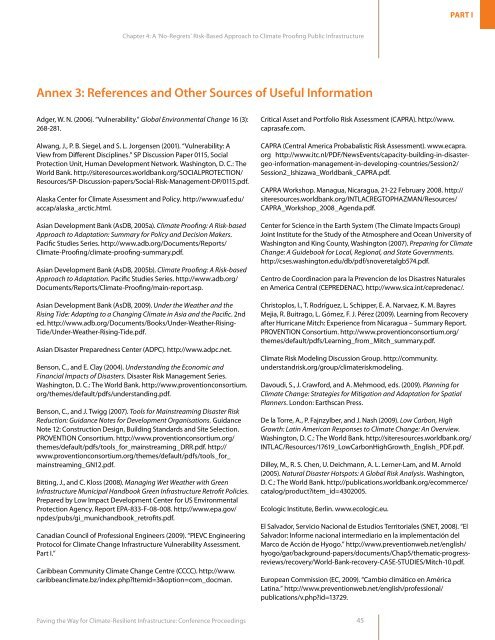Paving the Way for Climate-Resilient Infrastructure - UN CC:Learn
Paving the Way for Climate-Resilient Infrastructure - UN CC:Learn
Paving the Way for Climate-Resilient Infrastructure - UN CC:Learn
Create successful ePaper yourself
Turn your PDF publications into a flip-book with our unique Google optimized e-Paper software.
PART IChapter 4: A ‘No-Regrets’ Risk-Based Approach to <strong>Climate</strong> Proofing Public <strong>Infrastructure</strong>Annex 3: References and O<strong>the</strong>r Sources of Useful In<strong>for</strong>mationAdger, W. N. (2006). “Vulnerability.” Global Environmental Change 16 (3):268-281.Alwang, J., P. B. Siegel, and S. L. Jorgensen (2001). “Vulnerability: AView from Different Disciplines.” SP Discussion Paper 0115, SocialProtection Unit, Human Development Network. Washington, D. C.: TheWorld Bank. http://siteresources.worldbank.org/SOCIALPROTECTION/Resources/SP-Discussion-papers/Social-Risk-Management-DP/0115.pdf.Alaska Center <strong>for</strong> <strong>Climate</strong> Assessment and Policy. http://www.uaf.edu/accap/alaska_arctic.html.Asian Development Bank (AsDB, 2005a). <strong>Climate</strong> Proofing: A Risk-basedApproach to Adaptation: Summary <strong>for</strong> Policy and Decision Makers.Pacific Studies Series. http://www.adb.org/Documents/Reports/<strong>Climate</strong>-Proofing/climate-proofing-summary.pdf.Asian Development Bank (AsDB, 2005b). <strong>Climate</strong> Proofing: A Risk-basedApproach to Adaptation. Pacific Studies Series. http://www.adb.org/Documents/Reports/<strong>Climate</strong>-Proofing/main-report.asp.Asian Development Bank (AsDB, 2009). Under <strong>the</strong> Wea<strong>the</strong>r and <strong>the</strong>Rising Tide: Adapting to a Changing <strong>Climate</strong> in Asia and <strong>the</strong> Pacific. 2nded. http://www.adb.org/Documents/Books/Under-Wea<strong>the</strong>r-Rising-Tide/Under-Wea<strong>the</strong>r-Rising-Tide.pdf.Asian Disaster Preparedness Center (ADPC). http://www.adpc.net.Benson, C., and E. Clay (2004). Understanding <strong>the</strong> Economic andFinancial Impacts of Disasters. Disaster Risk Management Series.Washington, D. C.: The World Bank. http://www.proventionconsortium.org/<strong>the</strong>mes/default/pdfs/understanding.pdf.Benson, C., and J. Twigg (2007). Tools <strong>for</strong> Mainstreaming Disaster RiskReduction: Guidance Notes <strong>for</strong> Development Organisations. GuidanceNote 12: Construction Design, Building Standards and Site Selection.PROVENTION Consortium. http://www.proventionconsortium.org/<strong>the</strong>mes/default/pdfs/tools_<strong>for</strong>_mainstreaming_DRR.pdf. http://www.proventionconsortium.org/<strong>the</strong>mes/default/pdfs/tools_<strong>for</strong>_mainstreaming_GN12.pdf.Bitting, J., and C. Kloss (2008). Managing Wet Wea<strong>the</strong>r with Green<strong>Infrastructure</strong> Municipal Handbook Green <strong>Infrastructure</strong> Retrofit Policies.Prepared by Low Impact Development Center <strong>for</strong> US EnvironmentalProtection Agency. Report EPA-833-F-08-008. http://www.epa.gov/npdes/pubs/gi_munichandbook_retrofits.pdf.Canadian Council of Professional Engineers (2009). “PIEVC EngineeringProtocol <strong>for</strong> <strong>Climate</strong> Change <strong>Infrastructure</strong> Vulnerability Assessment.Part I.”Caribbean Community <strong>Climate</strong> Change Centre (<strong>CC</strong><strong>CC</strong>). http://www.caribbeanclimate.bz/index.php?Itemid=3&option=com_docman.Critical Asset and Portfolio Risk Assessment (CAPRA). http://www.caprasafe.com.CAPRA (Central America Probabalistic Risk Assessment). www.ecapra.org http://www.itc.nl/PDF/NewsEvents/capacity-building-in-disastergeo-in<strong>for</strong>mation-management-in-developing-countries/Session2/Session2_Ishizawa_Worldbank_CAPRA.pdf.CAPRA Workshop. Managua, Nicaragua, 21-22 February 2008. http://siteresources.worldbank.org/INTLACREGTOPHAZMAN/Resources/CAPRA_Workshop_2008_Agenda.pdf.Center <strong>for</strong> Science in <strong>the</strong> Earth System (The <strong>Climate</strong> Impacts Group)Joint Institute <strong>for</strong> <strong>the</strong> Study of <strong>the</strong> Atmosphere and Ocean University ofWashington and King County, Washington (2007). Preparing <strong>for</strong> <strong>Climate</strong>Change: A Guidebook <strong>for</strong> Local, Regional, and State Governments.http://cses.washington.edu/db/pdf/snoveretalgb574.pdf.Centro de Coordinacion para la Prevencion de los Disastres Naturalesen America Central (CEPREDENAC). http://www.sica.int/cepredenac/.Christoplos, I., T. Rodríguez, L. Schipper, E. A. Narvaez, K. M. BayresMejia, R. Buitrago, L. Gómez, F. J. Pérez (2009). <strong>Learn</strong>ing from Recoveryafter Hurricane Mitch: Experience from Nicaragua – Summary Report.PROVENTION Consortium. http://www.proventionconsortium.org/<strong>the</strong>mes/default/pdfs/<strong>Learn</strong>ing_from_Mitch_summary.pdf.<strong>Climate</strong> Risk Modeling Discussion Group. http://community.understandrisk.org/group/climateriskmodeling.Davoudi, S., J. Craw<strong>for</strong>d, and A. Mehmood, eds. (2009). Planning <strong>for</strong><strong>Climate</strong> Change: Strategies <strong>for</strong> Mitigation and Adaptation <strong>for</strong> SpatialPlanners. London: Earthscan Press.De la Torre, A., P. Fajnzylber, and J. Nash (2009). Low Carbon, HighGrowth: Latin American Responses to <strong>Climate</strong> Change: An Overview.Washington, D. C.: The World Bank. http://siteresources.worldbank.org/INTLAC/Resources/17619_LowCarbonHighGrowth_English_PDF.pdf.Dilley, M., R. S. Chen, U. Deichmann, A. L. Lerner-Lam, and M. Arnold(2005). Natural Disaster Hotspots: A Global Risk Analysis. Washington,D. C.: The World Bank. http://publications.worldbank.org/ecommerce/catalog/product?item_id=4302005.Ecologic Institute, Berlin. www.ecologic.eu.El Salvador, Servicio Nacional de Estudios Territoriales (SNET, 2008). “ElSalvador: In<strong>for</strong>me nacional intermediario en la implementación delMarco de Acción de Hyogo.” http://www.preventionweb.net/english/hyogo/gar/background-papers/documents/Chap5/<strong>the</strong>matic-progressreviews/recovery/World-Bank-recovery-CASE-STUDIES/Mitch-10.pdf.European Commission (EC, 2009). “Cambio climático en AméricaLatina.” http://www.preventionweb.net/english/professional/publications/v.php?id=13729.<strong>Paving</strong> <strong>the</strong> <strong>Way</strong> <strong>for</strong> <strong>Climate</strong>-<strong>Resilient</strong> <strong>Infrastructure</strong>: Conference Proceedings 45
















